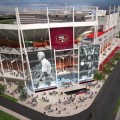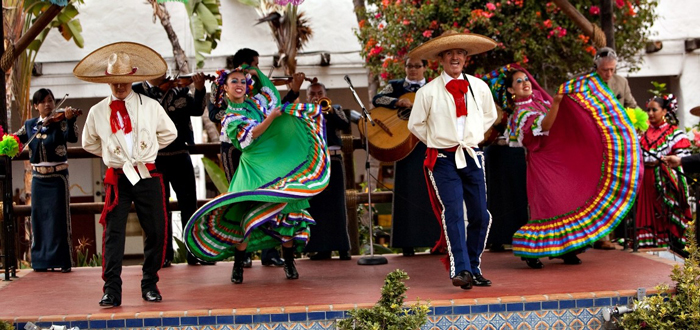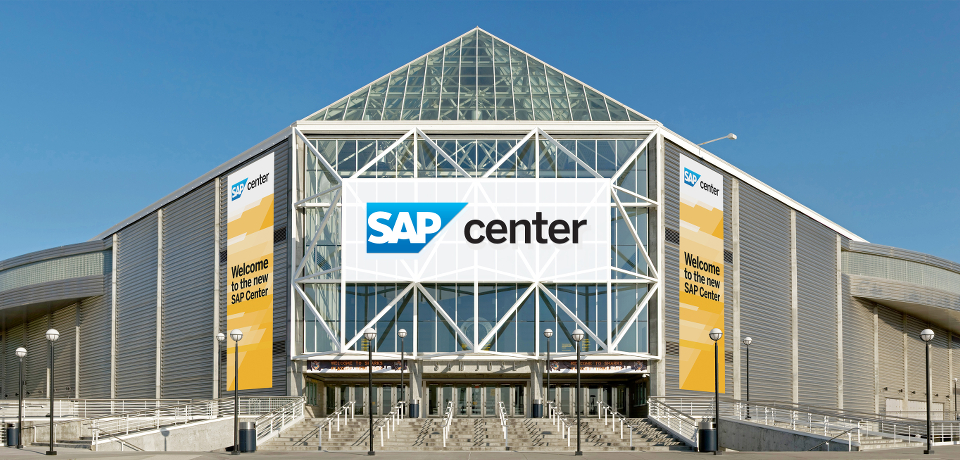On the eve of baseball season’s Opening Day—and more than two years since Major League Baseball Commissioner Bud Selig formed a blue ribbon panel to study the relocation of the Oakland A’s—San Jose still sits by the phone like a lonely lover. The city waits, pines, hopes for a call, some news … anything.
The future of professional sports in the nation’s 10th largest city is in limbo. In furious preparations for an opportunity that may never materialize—and to protect the land holdings that may one day house a ballpark—San Jose has taken extraordinary steps.
The San Francisco Giants hold rights to the San Jose market area, which they got when the club was considering a move to the area in 1990. And now the World Series champions are standing in the way of San Jose’s own bid for pro sports glory.
Pulling a page from the “if you build it, they will come” playbook of the late 1980s, when San Jose broke ground on an arena before a sports team signed up to play here, the City Council three weeks ago created a new quasi-public entity and transferred several large chunks of real estate to its control.
The new San Jose Diridon Development Authority now controls nine parcels that the city purchased over a 15-year period for more than $25 million. Seven of them lie directly adjacent to Diridon Station and south of HP Pavilion. Like a runner on third base when the pitcher’s back is turned, the city is charging forward to claim more pieces of land for the stadium grounds.
Slated to become Bay Area’s transit epicenter—including the region’s high-speed rail gateway to Southern California—Diridon Station’s surroundings almost certainly will grow well beyond their current value. That’s why the city and the Redevelopment Agency took the unprecedented—and, some believe, legally questionable—step. Gov. Jerry Brown’s threat to shutter the state’s 400-plus redevelopment agencies to shore up California’s broke state government prompted San Jose’s hardball play.
Viewed in a more cautious light, MLB’s foot-dragging and the state’s ambitions on local funds might have given city leaders pause to slow down. The outside pressure, however, only seems to have steeled the city’s resolve and increased its sense of urgency in recent weeks.
Technically, the new development authority has a non-specific charter and retains decision-making discretion on the land’s ultimate uses. And even though the resolution declares that “there are no specific projects proposed for the Authority,” San Jose officials believe that baseball and San Jose would be good together, if given a chance.
The planning process could begin as early as an April 28 City Council study session. The baseball commissioner’s unreleased report is presumed to be complete, believes Mayor Chuck Reed, who has not heard from MLB in nearly two months and is running out of patience.
“The pace the commissioner is working at makes government’s processes look good,” Reed says. “We were slow, but we’re nowhere near as slow as the pace the commissioner was working.” (The commissioner previously asked the city to delay a November 2010 referendum on the ballpark until spring, but then blew past that deadline.)
{pagebreak}
Contingency plans are underway as well for the ballpark property. Corporate offices, upmarket retail spaces and residential buildings are among the fall-back options. A 32,000-seat ballpark as a downtown anchor, however, would be the city’s crown jewel, imbuing the city with sex appeal and helping it outgrow its self-esteem issues.
“We’ve been in contact with MLB on a fairly regular basis up until a month ago,” Redevelopment Agency Executive Director Harry Mavrogenes says. “They’ve asked for maps and information, so I’m assuming the committee has concluded its work. But I have no answer when MLB will make a decision. And that’s the critical thing: We really need to hear what the decision will be from MLB.”
Ballpark proponents argue that projects for a BART station at Diridon would advance with greater confidence; High-Speed Rail’s timetable could accelerate; and downtown would finally be able to attract retailers and companies that it regularly loses to suburbs and shopping centers.
For now, San Jose has positioned itself to speedily erect a ballpark by aggregating the dirt and establishing the authority, which also shelters the strategic assets from a Sacramento grab. “All we’ve done is set up the shell, and there’s not been any further discussion on how to fill that shell,” Mavrogenes says. “If we hear something, I would imagine we would mobilize fairly quickly.”
Negotiating principles mapped out by the City Council require the A’s and their corporate sponsors to shell out the entire $489 million it will take to build the stadium. No public money would be spent—nor would taxes be raised—to fund the project and its surrounding infrastructure.
The city would lease the land to the team over several decades, as it is leasing property for a soon-to-be-built soccer stadium for the San Jose Earthquakes, which shares ownership with the A’s.
Ballpark opponents argue that public money will be spent and few jobs will be created. A debate is emerging on the future of Montgomery Street, the fault line of the Authority’s land. And while local opposition is scattered and weak, the ballpark proposal faces a towering, powerful opponent: the World Series champions.
{pagebreak}
The Big Guys
Life is good these days for the San Francisco Giants. Fresh off their first title since fleeing New York in 1958, the team practices its craft in what many fans consider America’s most beautiful ballpark. The club features a clutch of celebrity ballplayers beloved for their eccentricities. Closer Brian Wilson’s beard was winning before Charlie Sheen, while slugger Aubrey Huff’s red thong was a stirrup of a different stripe. And San Jose’s own Pat Burrell made a few gimpy appearances as The Machine, which was, well, unsettling. A parade and million-fan celebration in front of San Francisco’s City Hall greeted their return from the Texas victory.
Not too long ago the A’s were those guys. The team featured a similar lineup of characters, from killer closer Dennis Eckersley and the Bash Brothers—Mark McGwire and Jose Canseco—to the swift and eloquent Rickey Henderson. The A’s won three straight pennants, and a World Series in 1989.
Times have changed, however, and fate has dealt Oakland a cold deck. Now it’s Oakland that hopes that General Manager Billy Beane’s “Moneyball” approach—more maligned with each passing season—can persuade a moribund fan base to support a franchise that is signaling for the check.
The model that the A’s have in mind for the future is similar to that of their cross-bay counterparts: create buzz with a pristine, privately-financed stadium and hope that a roster rooted in pitching and productive role players will pay off. Unfortunately for the A’s, San Francisco’s cruel strategy extends south to Sharks Territory.
At a time when South Bay might hope to be rewarded for their decades of loyalty to the San Francisco team, they seem to be getting an oversized foam middle finger from Los Gigantes, who now seemingly could afford to be magnanimous. “It’s a classic example of greed, and forgetting who got you where you are,” says one lifelong San Josean who didn’t want to be identified, even though his name appears on local buildings.
Back in 1989, with a drafty ballpark rattled by the Loma Prieta earthquake and a cooling fan base, Giants owner Bob Lurie approached the A’s about moving the Giants south to San Jose. A’s owner and Levi Strauss heir Walter Haas ceded Santa Clara County territorial rights to Lurie without as much as a second thought.
San Jose City Attorney Richard Doyle was at the table as a staff attorney when the Giants were trying to make the move. Giants officials needed help putting a referendum on the ballot. Looking back, Doyle says he was astounded to hear how easily rights to the San Jose fandom had been discarded like unwanted hand-me-downs. Haas wasn’t interested in going through the normal MLB channels to facilitate a team’s relocation.
“Haas gave away territorial rights, and the Giants never gave them back,” Doyle says. “So, this whole idea of the Giants having territorial rights—had you been at the table, it’s not something that was bargained for or bought. The A’s gave them to them.”
{pagebreak}
It bears mentioning that the benevolent late Haas could have viewed the Giants’ exodus from San Francisco with a keen business eye. Fans would then have to drive either an hour to San Jose or simply motor across the Bay Bridge to see the Bash Brothers.
Lurie twice tried to get ballot measures passed to help tax-fund a stadium in Santa Clara County—once in November 1990 and again in June 1992. But Lurie, underestimating local voters’ thriftiness in the throes of the pre-Dotcom Boom recession, headed home without a stadium deal.
What no one seemed to notice or care about was that the Giants had captured a bargaining chip that no other MLB club had at the time or has today. More than two decades after trying to abandon San Francisco for San Jose, gifted territorial rights gave the Giants blocking power to keep what became the 10th-largest city in America from having a baseball team of its own.
Lurie sold the Giants in 1993, and by that time the team’s territorial veto remained with the franchise like a conquered and annexed nation. The Giants abandoned their South Bay ambitions to build a ballpark in San Francisco and constructed Pac Bell (now AT&T) Park with just 5 percent public funding. Peter Magowan oversaw the club until handing over managing general partner duties in 2008 to former Microsoft lawyer Bill Neukom, who, along with the current A’s ownership and MLB, declined to be interviewed for this article.
Two years after Lurie’s exit, A’s ownership changed hands as well. In 1995, Haas sold control to Silicon Valley developer Steve Schott, a graduate of Bellarmine College Preparatory and Santa Clara University, and East Bay builder Ken Hofmann.
The two men tried to renovate the Coliseum but were thwarted by Raiders owner Al Davis. His football team’s return to Oakland from Los Angeles brought lawsuits and the Coliseum’s uglification, obliterating any hopes for a suitable A’s ballpark in the future. The fan base soured and nostalgia for Haas built to such a level that one would think the munificent former owner had bought rounds in the bleachers on day games.
With no progress being made towards an Oakland stadium, and little affection for the way Schott and Hofmann conducted their business, Commissioner Bud Selig turned to a former fraternity brother to help revive the Athletics.
The Cash Brothers
More than 50 years ago, Lew Wolff and Bud Selig became members of a University of Wisconsin fraternity. Selig stayed out of trouble and took his role as president of the Pi Lambda Phis seriously; Wolff leaned more towards the John Belushi side of the house.
After graduation, the two men went their separate ways. Wolff headed home to St. Louis, got his MBA and went on to become a real estate developer. He came to the Bay Area and had an important role in building Park Center Plaza, downtown San Jose’s first revitalization effort in the early 1970s. Wolff remained active in San Jose development for the next four decades, and has a hand in developing most of the buildings north of the Adobe Towers on Almaden Boulevard and on the west side of downtown’s Plaza de César Chávez. Along with cannery heir Phil Dinapoli, he built and opened downtown’s Hilton in 1992, and bought into and expanded the Fairmont Hotel. His holdings include sports teams, luxury hotels and office developments from California and the Midwest to the Caribbean and Brazil.
Wolff’s knack for getting what he wants and his outspokenness have been valuable business qualities that have recently made him a bit of a thorn in Selig’s side.
{pagebreak}
Selig spent a couple years in the army before returning home to Milwaukee to work as a salesman at his father’s car dealership. His passion outside of work was baseball, thanks to his mother, who took him and his brother to minor league games as kids.
Selig was such a devoted fan of the game that he ended up taking the money he made selling and leasing cars and investing it in the Milwaukee Braves, who relocated from Boston in 1953. It wasn’t long before Selig became the Braves’ biggest public shareholder. But then, in 1965, the team abandoned Wisconsin and exited to Atlanta.
The sting of losing his team to another market without an ounce of control stayed with Selig. He made it his mission to restore baseball in Milwaukee, and in 1970 he brought the struggling Seattle Pilots to Wisconsin and renamed the franchise the Brewers. Twenty-two years later, he became the commissioner of baseball.
More than five decades after leaving the comfy confines of Madison, baseball brought the two fraternity brothers back together.
In 2002, Selig invited Wolff to fly from Paris to San Francisco to attend a game during the Bay Bridge World Series. According to a San Francisco magazine piece by Steve Kettmann, that’s where Selig gauged Wolff’s interest in buying a stake in the Oakland Athletics. A year later, Wolff joined Schott and Hofmann as owners.
Wolff’s job was to find a stadium. He exhausted four different options in Oakland before spending tens of millions on a failed multiuse project in Fremont. But Wolff’s eyes had always been set on San Jose, the place where he started his career, and near where his daughter and young grandsons live.
Twelve years ago, Wolff told Kettmann, then a San Francisco Chronicle writer: “If I was going to pursue a ballpark, I would certainly do it in San Jose, not depend on a vote outside of San Jose, and I would work through the mayor and the Redevelopment Agency. It’s the difference between a big-league city and a non-big-league city. I wouldn’t spend five minutes on any other city besides San Jose.”
Six years after that interview, Wolff and Gap billionaire Jim Fisher took control of the club. From there, it seems, it was only a matter of where to and how soon.
But since Wolff and Selig’s warm reunion, the relationship has become more complex. Wolff and Fisher are still making money, thanks to Major League Baseball’s communist-style revenue-sharing system. But the A’s—and the rest of baseball—lose millions due to weak attendance and poor amenities at the Oakland Coliseum.
In the two years since Selig formed the blue ribbon panel to study the A’s options, Wolff has expressed his weariness with the process.
“The committee hopefully has finished its work, and Bud is contemplating his decision. That’s all I know,” Wolff told the Associated Press. “I think it will be sooner rather than later. I don’t think it’s another year off.”
That interview took place almost a year ago.
{pagebreak}
Conducting his business behind closed doors and at the pace of an interminable meeting on the pitcher’s mound, Selig has consistently said that the committee will announce its report once it’s complete. The reality is, he and Wolff aren’t getting any younger—both are in their late ’70s.
“It seems to me a great legacy for Bud Selig would be to have rebuilt or upgraded the stadium of every team in the league,” says Baseball San Jose co-chair Michael Mulcahy. “To have touched every team rather than the stench of a Barry Bonds trial gone wrong.”
The Giants steadfastly refuse to cede control of Santa Clara County, citing a pre-existing fanbase and the potential for millions in lost Silicon Valley advertising and sponsorship revenue.
At 69 years of age, it would be easy to pass Neukom at the ballpark and think you’ve just come across an eccentric senior citizen fond of bow ties and baseball. Neukom built a fortune as the lead general counsel for Microsoft, battling the federal government’s anti-trust suits against the software giant for more than 20 years. He understands well that for the past 90 years, Major League Baseball has enjoyed a rare status as a legally-sanctioned monopoly that allows it to defy market-based economics.
“Neukom is a streetfighter,” says Larry Stone, Santa Clara County’s assessor. “He’s an attorney, and a damn good one by the way. No matter how you feel about this, you have to admire Bill Neukom. He’s no dummy.”
Stone theorizes that the threat of litigation by AT&T Park investors has hampered Selig’s efforts to put the A’s request to relocate to a vote of MLB owners, 75 percent of whom will have to vote in favor at a league meeting. A ballot measure would then have to be approved by voters, most likely this November. All Wolff can do is wait.
Stealing a Base
Baseball’s monetary value to San Jose is still debatable. Jobs are one thing, but actual economic impact is another. The state will likely have to decide the legality of shell organizations like the Diridon Development Authority, as well as similar schemes, such as Santa Clara County’s recent transfer of $4 million to the San Francisco 49ers to pave the way for a new stadium.
Those actions could be challenged by Brown to recoup money needed to make a dent in California’s $26 billion deficit.
“The governor’s proposal allows for a thorough review of the actions cities and redevelopment agencies have been taking to sequester and fast-track funds,” Evan Westrup, Brown’s spokesman, was quoted as saying in a recent article in the San Francisco Chronicle. “If violations of the law are found, subsequent action can be considered and/or pursued.”
“If this happens,” Doyle says laughing, “it’s a lawyers dream, because litigation is going to happen for five years.”
Redevelopment’s goal is to increase property taxes, and Mayor Reed says that objective is the most important reason to build a sports facility. An impact analysis report by Convention, Sports & Leisure International says an annual average of $3.5 million would be generated for the city by building a stadium.
“In addition to the jobs, both construction and permanent,” Reed says, “it’s really about the tax revenues. That’s a big plus in these economic times.”
Marc Morris, a software developer who runs a stadium opposition website called Better Sense San Jose, says the numbers from a city-commissioned ballpark economic impact analysis are misleading.
“A baseball team is really just a small business with big publicity,” Morris says.
{pagebreak}
A more difficult issue to tackle is the psychic and emotional importance of sports to American culture, and the civic pride that can surround a winning team.
“I guess I can say there is a false civic pride, because it sets you up for blackmail in the future,” Morris says. “An owner can say if you don’t give me more money, a new stadium, I’m going to leave.”
Over time, though, San Jose has become the A’s only true option. Oakland has just begun developing an environmental impact report, a prerequisite completed years ago in San Jose, and, as Redevelopment’s Mavrogenes points out, Wolff “made it clear to everyone that he does not want to build a facility in Oakland.”
Local business leaders here are clearly on board. The Silicon Valley Leadership Group sent a letter signed by 75 local CEOs to Selig late last year, endorsing the team’s relocation to San Jose. Included in that group were Carol Bartz of Yahoo; Shantanu Narayen of Adobe; and John Chambers of Cisco, which has a $120 million deal with the A’s for 30 years of naming rights if a stadium is built.
None of this has softened the Giants’ stance. They’ve ruled out a deal for giving up the territory. The reason is clear: Why allow the A’s to suck Silicon Valley corporate and fan revenue when a waiting game could result in a one-team Bay Area baseball market?
“I understand the Giants are trying to either get the A’s to leave the area, which would be in their interest, or get some money out of the A’s,” Reed says. “But I don’t think it’s right the way they’re holding San Jose hostage.”
Making the situation more pressing is an impending collective bargaining agreement at the end of this season. Growing chatter speculates that the league will contract to 28 teams by eliminating the Tampa Bay Rays and the A’s. As one team executive told the New York Daily News, “How much longer can you expect all the other teams to subsidize two teams, in futile situations, with revenue sharing to keep them afloat?”
Contraction, however, seems unlikely in the face of a wave of lawsuits—from the MLB Players Association and host cities themselves. Even San Jose could sue for the right to bring the A’s to town, although city officials say they have not discussed that option.
One thing is certain: The A’s won’t sue the Giants, nor vice versa, due to the immunity from federal anti-trust laws baseball received a century ago as part of an arcane dispute over players’ rights. MLB rules prevent clubs from litigating because of the fraternity they share as members of the league.
A stumbling block might be the unpaid portion of the $170 million loan the Giants took from Chase Manhattan Bank to build AT&T Park. “I think the only way this is going to work politically is if an agreement is reached,” says admitted local baseball booster Larry Stone. “Although Lew Wolff doesn’t expect to give the Giants anything, my theory is the A’s pay down the loan.”
In the meantime, the mysterious Diridon Development Authority exists in a vacuum, with no known leadership or definitive plans. While unlikely, it’s possible the city could toss in a few more properties for protection from the state. One parcel already included is on San Fernando Street, six blocks away from the proposed ballpark site but seen as a gateway to the ballpark.
Meanwhile, South Bay baseball fans wait, and San Jose remains perched on the cusp of becoming something it has always wanted to be—a major league city.
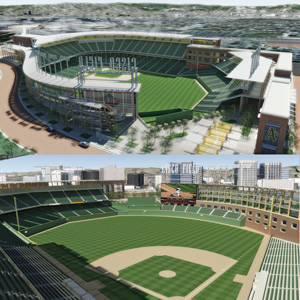
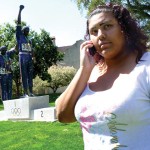 San Jose State Faces Major Budget Cuts
San Jose State Faces Major Budget Cuts 